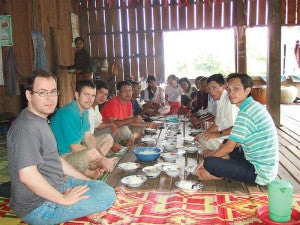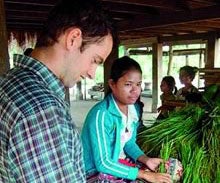In 1993, Vietnam began building a dam on its portion of the Se San River. It was intended to provide hydroelectric power for its citizens, but had downstream effects in villages along the Se San in northeastern Cambodia that the original environmental impact assessment did not anticipate. In 2005, Tyler Giannini, the clinical director of the law school’s Human Rights Program, and students from the International Human Rights Clinic traveled to riverside villages in Cambodia to investigate the dam’s effects. They found that water surges had drowned people and animals, depleted fish populations, damaged property, and rendered fishing and panning for gold dangerous.
Last October, Matt Bugher ’09 and Andrew McIntyre LL.M. ’08, students in the clinic, accompanied Giannini on a return trip to Cambodia. They met with Cambodian officials and community organizations, encouraging public participation to address lingering concerns about the dam and proposing that outside mediators be brought in to foster communication between the government and civic groups.
Photograph of Bugher
Andrew McIntyre
Dinner in Sam Kha: Tyler Giannini (far left) and Bugher are guests at a meal in the Cambodian village, where they’ve interviewed residents and documented the effects of flooding and erosion.

While environmental lawyers have brought court cases in similar situations, the clinic has relied on grassroots organizing more than on litigation. “If there is to be a law reform effort,” McIntyre said, “it should come from the Cambodian civil society organizations and NGOs.” McIntyre reviewed draft environmental impact assessment regulations in light of international principles, and Cambodian community groups used his research to comment on the proposed regulations. With McIntyre, Bugher worked to show that the villagers’ displacement was a form of involuntary relocation, a position that he believes will have “persuasive power” with the government in ongoing negotiations with the villagers.
